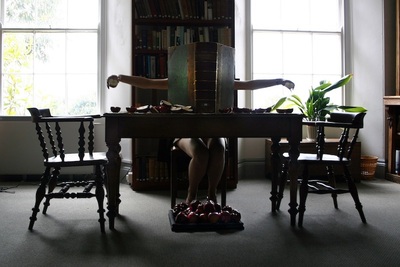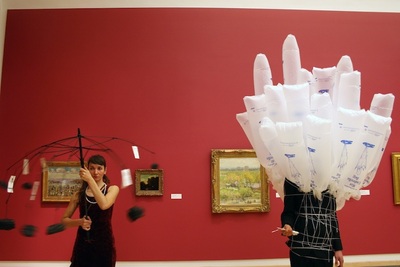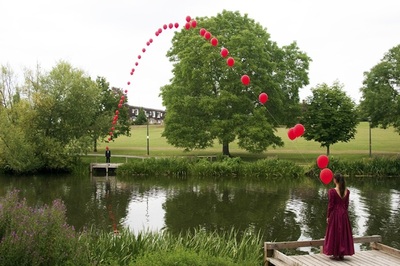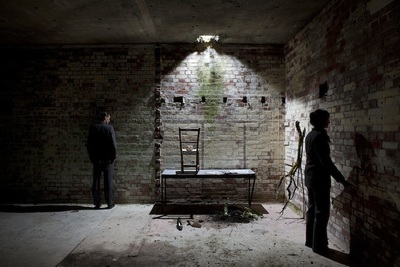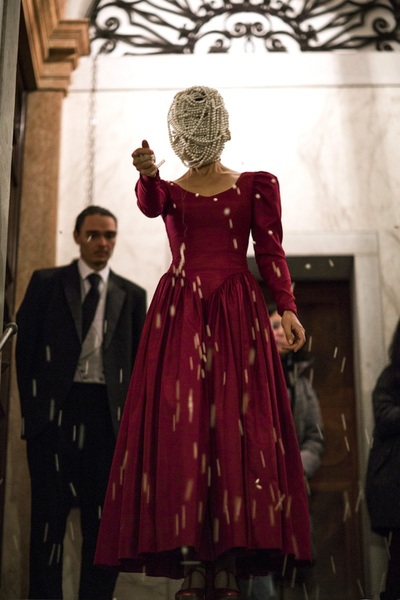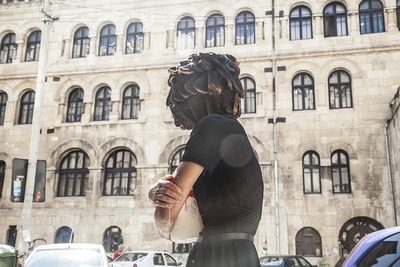|
I am truly delighted to initiate the Performance Is Alive: Artist Feature Series with the compelling performance duo, ZIERLE & CARTER! I met Alexandra Zierle and Paul Carter in 2011 at Grace Exhibition Space (Brooklyn, NY) following their durational work, Love Spills. Zierle (DE) & Carter (UK) perform around the world, presenting dynamic work that investigates relationships and inter-connectivity. I asked the duo a few questions that are the cornerstone of this site. Their response can be found (in full) below. - Quinn Dukes Quinn: What led you both to performance art? Alexandra: My first encounters with performance art happened when I still lived in Germany and studied photography. These encounters were quite fleeting, yet left a residue, an undefined mark, especially when I was asked to participate in a devised performance piece by a local visual artist and lecturer. More pivotal to mention as an early encounter with performative actions are shamanic rituals I observed throughout my travels in Asia. At times I was a direct participant in the ʻgroup actionʼ of a ritual and the energy transference that took place from one human being to the other. These deliberate, symbolised actions made a strong and lasting impression. Later when I studied sculpture, I often referred back to these experiences and realised that the actual making processes, material led explorations, and the repetitive actions involved communicated a crucial aspect of the work, which the end product - the sculpture - had lost or kept hidden from the viewer. So moving from photography, sculpting with light via process and material led sculptures led into performance for the camera, where my body and ritualised actions became the material and vehicle for communication. The camera as the only witness moved into the background when we left our studio practice. After graduating we found ourselves working predominantly with site responsive projects, especially when we were backpacking through Argentina and Chile on a travel scholarship exploring ʻsense of belongingʼ in a Welsh community in Patagonia. I had a profound experience during a solo performance of a ritualised action in the streets of Buenos Aires. This reminded me of the energy transference similar to the shamanic rituals earlier on in my life, but this time it was in public with a spontaneously gathered audience of passerbyʼs. Being able to experience these extraordinary shared moments with an audience during live performances and being able to communicate beyond words is what keeps our performance practice alive and growing. Paul: I can honestly say that I first started to work with and became interested in performance through Alexandra whilst studying, just before and as we were getting together in a relationship. At that moment, I was expanding and exploring my notions of the world and experimenting artistically. My desire to explore different media was already planted but when I started to work closely with Alexandra on video works, assisting and being assisted, I was inspired to explore the potential performativity within its process, initially staging actions for camera. At a similar time, I was also making large sculptural wall reliefs, charged with actions and processes, fascinated by notions of cause and effect, chance, elemental forces, conscious action and the fine and blurred line between what we ʻdoʼ and set into motion and what is beyond our control and left to natural and other such forces. I was making embodied, large, physical, tactile and time labored works that seem to imbue and encapsulate a micro-history of its maker but layered, intertwined and covered by its ʻobjectnessʼ, scale and modes and contexts of presentation. When showing the work, it was as if ʻthe workʼ was being seen as something separate from its maker. I began to realise that I was more interested in the experience of making/doing as the work rather than the finished product. I wanted people to experience the process and not the final object. It became clear that the dynamic between the body, time, space and those present were the materials for the work, something I now regard as the fabric of the present moment. Collaboratively: The process of actually making live performance and collaborating together was a natural and gradual process, though, the catalyst for our collaboration came somewhat unintentionally, dictated by an idea. At the beginning of our relationship, Alexandra had created a ʻback to backʼ suit, a black suit with its tops and bottoms sewn back to back, which by default needed two bodies to activate. Initially the focus for the work was not intended to be about our relationship, instead exploring more universal relational themes. The intense process of wearing the suit for 8 hours a day performing, at times, strenuous and conflicting actions in varying scenarios for two weeks - it was inevitable that the material of the work was as much our relationship dynamic that it was a universal exploration. This work was created initially for camera and later led to our first collaborative live and public performance. The experience was incredibly potent and challenging for us, it was our initiation into collaborating, all consuming, blurring life and art. Dialogues surrounding the work/our relationship spilled far beyond the confines of the studio where the work was made. It was not easy and it made us question each other and ourselves within our relationship as a couple as well as artistic collaborators on the work. This experience has set the tone for our subsequent collaborative practice and years down the line, though we as people have changed, the collaboration still has the same potency and potential. Almost 10 years on, we are interested in blurring the boundaries between the performed and the lived moment. Where a structure, a frame, a focus (which could be called performance) is applied to everyday experience, that operates to bring everybody, including the ʻperformersʼ into a state of heightened awareness, into a collectively shared and co-determined unknown moment, a departure from the parameters imposed by an art form or by societal conditioning, just a space of pure potential. It's the energy transference that takes place in a shared moment that fascinates us. When everyone involved, ʻperformersʼ and ʻaudienceʼ members alike, are linked in an invisible yet at times almost tangible stream of energy that assists in fully bringing about the sense of heightened awareness or presence - that facilitates extraordinary moments to be shared by everyone. These moments are very precious to us as in those instances subtle changes within the audience and us can occur, new thoughts are born, paradigm shifts can take place, and new ways of being together can be explored. When asked in an interview by Karlyn De Jongh and Valeria Romagnini “What was the necessity for you to perform with a partner together?” We replied that the initial idea of the suit dictated the use and presence of another body. It was unintentional and seemingly irrelevant at least at first that the two bodies were in a relationship as a couple. This experience had a profound influence on us both, though challenging, it enlivened us personally and creatively and birthed a deeper fascination of encountering the other within the work. The necessity comes from those moments where we are truly present together, both pulsing and breathing aliveness. Also asked “What are your intentions to express with your performances?” we answered that in some respects it is the same as in life; we intend to have heartfelt, sincere, poignant, challenging, memorable and transformative experiences with people. One of our main intentions is to communicate beyond what could be expressed through purely visual, spoken or written language. We are interested in people having embodied (in and from the body) ʻin the momentʼ experiences and responses, absorbing and connecting with the work on multiple levels, rather than analysing it purely through intellect or mediating it through socially conditioned filters. We invite people to get out of their rational minds, the familiar self defined constructs, and take a leap into the unknown. Through flipping everyday and universal actions/roles upside down, turning them inside out, reversing, or reverting them, we intend to initiate a new dialogue, a poetic around the potentiality of space, momentarily redefining what is possible. Planting seeds, presenting alternatives, whether the invitation is accepted or not. We intend to create a scenario that feels so other, yet ultimately grounded in the everyday and the ʻfamiliarʼ, that you are required to address and question your core beliefs in order to navigate that moment. QD: Are there performance artists working today that influence your practice? We are touched by elements of many performance artists but the following have had a significant impact: Alastair McLennan, Alexandros Plomaritis, Boris Nieslony, Christina Georgiou, Francesca Fini, Jill Orr, Kurt Johannessen, Lynn Lu, Sandra Johnson and VestAndPage.
All images are courtesy of the artists.
0 Comments
Your comment will be posted after it is approved.
Leave a Reply. |
CONTRIBUTORSIan Deleón Archives
July 2023
|
|
MISSION // Based in Brooklyn, NYC, PERFORMANCE IS ALIVE is an online platform featuring the work and words of current performance art practitioners. Through interviews, reviews, artists features, sponsorship and curatorial projects, we aim to support the performance community while offering an access point to the performance curious.
Performance Is Alive is a fiscally sponsored project of Fractured Atlas, a 501(c)(3) charity. Contributions made payable to Fractured Atlas for the purposes of Performance Is Alive are tax-deductible to the extent permitted by law. |

